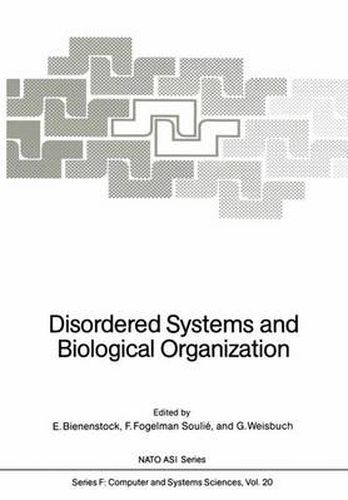Readings Newsletter
Become a Readings Member to make your shopping experience even easier.
Sign in or sign up for free!
You’re not far away from qualifying for FREE standard shipping within Australia
You’ve qualified for FREE standard shipping within Australia
The cart is loading…






This title is printed to order. This book may have been self-published. If so, we cannot guarantee the quality of the content. In the main most books will have gone through the editing process however some may not. We therefore suggest that you be aware of this before ordering this book. If in doubt check either the author or publisher’s details as we are unable to accept any returns unless they are faulty. Please contact us if you have any questions.
The NATO workshop on Disordered Systems and Biological Organization was attended, in march 1985, by 65 scientists representing a large variety of fields: Mathematics, Computer Science, Physics and Biology. It was the purpose of this interdisciplinary workshop to shed light on the conceptual connections existing between fields of research apparently as different as: automata theory, combinatorial optimization, spin glasses and modeling of biological systems, all of them concerned with the global organization of complex systems, locally interconnected. Common to many contributions to this volume is the underlying analogy between biological systems and spin glasses: they share the same properties of stability and diversity. This is the case for instance of primary sequences of biopo Iymers I ike proteins and nucleic acids considered as the result of mutation-selection processes [P. W. Anderson, 1983] or of evolving biological species [G. Weisbuch, 1984]. Some of the most striking aspects of our cognitive apparatus, involved In learning and recognttlon [J. Hopfield, 19821, can also be described in terms of stability and diversity in a suitable configuration space. These interpretations and preoccupations merge with those of theoretical biologists like S. Kauffman 1969 and of mathematicians of automata theory: the dynamics of networks of automata can be interpreted in terms of organization of a system in multiple possible attractors. The present introduction outlInes the relationships between the contributions presented at the workshop and brIefly discusses each paper in its particular scientific context.
$9.00 standard shipping within Australia
FREE standard shipping within Australia for orders over $100.00
Express & International shipping calculated at checkout
This title is printed to order. This book may have been self-published. If so, we cannot guarantee the quality of the content. In the main most books will have gone through the editing process however some may not. We therefore suggest that you be aware of this before ordering this book. If in doubt check either the author or publisher’s details as we are unable to accept any returns unless they are faulty. Please contact us if you have any questions.
The NATO workshop on Disordered Systems and Biological Organization was attended, in march 1985, by 65 scientists representing a large variety of fields: Mathematics, Computer Science, Physics and Biology. It was the purpose of this interdisciplinary workshop to shed light on the conceptual connections existing between fields of research apparently as different as: automata theory, combinatorial optimization, spin glasses and modeling of biological systems, all of them concerned with the global organization of complex systems, locally interconnected. Common to many contributions to this volume is the underlying analogy between biological systems and spin glasses: they share the same properties of stability and diversity. This is the case for instance of primary sequences of biopo Iymers I ike proteins and nucleic acids considered as the result of mutation-selection processes [P. W. Anderson, 1983] or of evolving biological species [G. Weisbuch, 1984]. Some of the most striking aspects of our cognitive apparatus, involved In learning and recognttlon [J. Hopfield, 19821, can also be described in terms of stability and diversity in a suitable configuration space. These interpretations and preoccupations merge with those of theoretical biologists like S. Kauffman 1969 and of mathematicians of automata theory: the dynamics of networks of automata can be interpreted in terms of organization of a system in multiple possible attractors. The present introduction outlInes the relationships between the contributions presented at the workshop and brIefly discusses each paper in its particular scientific context.